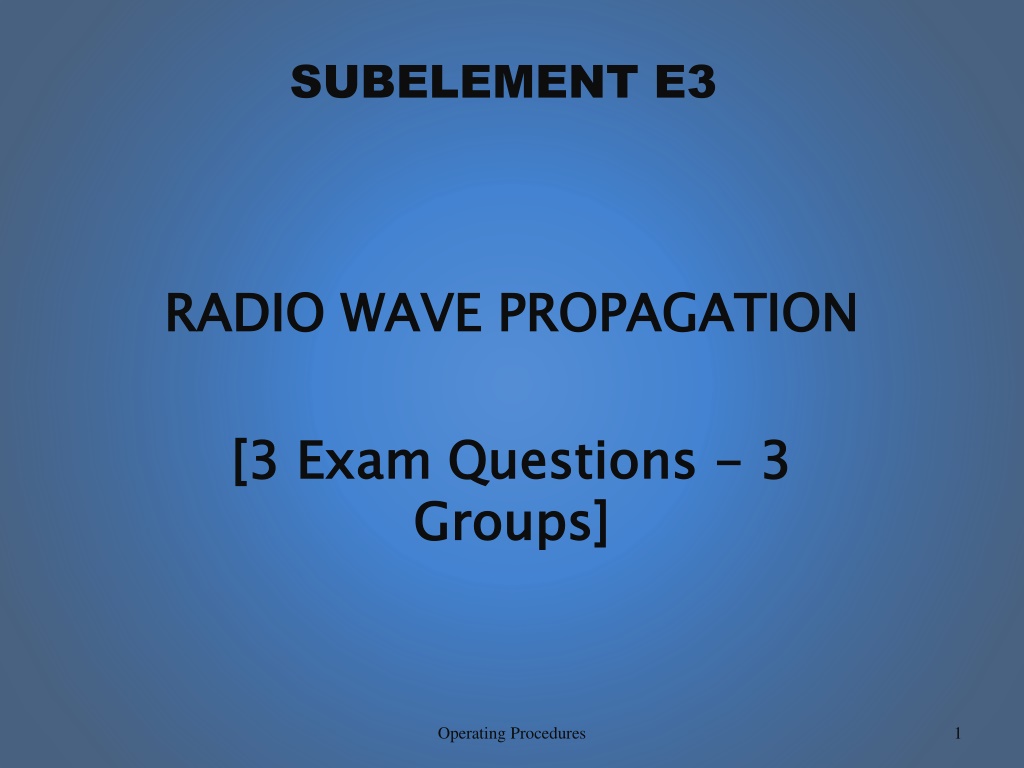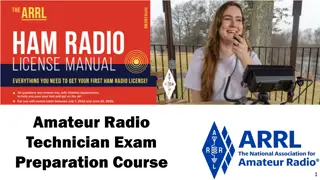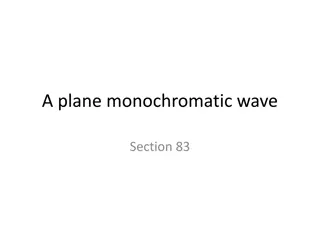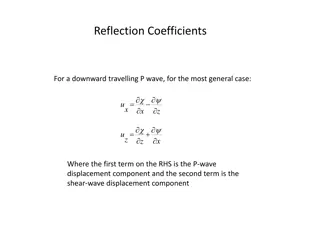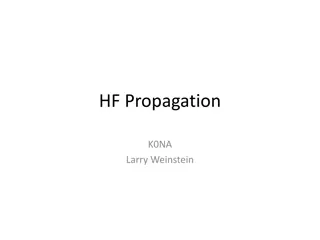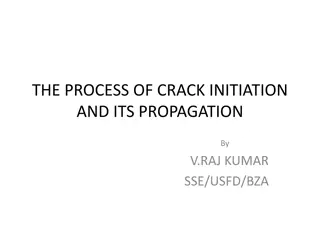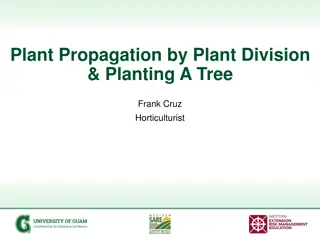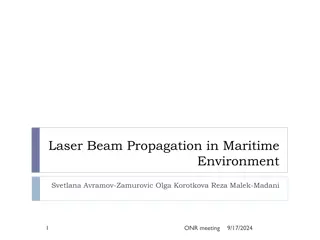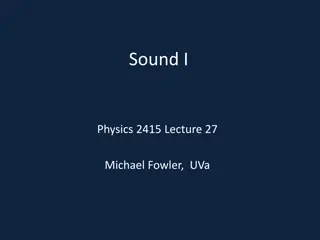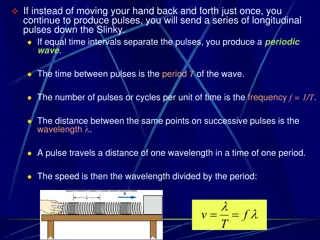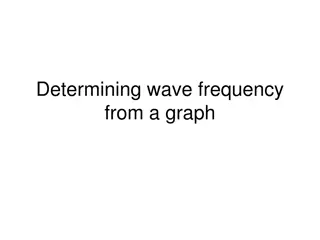Understanding Radio Wave Propagation and Operating Procedures in Subelement E3
Explore the fascinating world of radio wave propagation, including topics such as Earth communications, meteor scatter, microwave propagation, aurora propagation, and various techniques like trans-equatorial propagation. Learn about the maximum separation between stations communicating by Moon bounce, libration fading of EME signals, and more operating procedures in Subelement E3.
- Radio Wave Propagation
- Operating Procedures
- Subelement E3
- Communication Techniques
- Electromagnetic Waves
Download Presentation

Please find below an Image/Link to download the presentation.
The content on the website is provided AS IS for your information and personal use only. It may not be sold, licensed, or shared on other websites without obtaining consent from the author. Download presentation by click this link. If you encounter any issues during the download, it is possible that the publisher has removed the file from their server.
E N D
Presentation Transcript
SUBELEMENT E3 RADIO WAVE PROPAGATION RADIO WAVE PROPAGATION [ [3 Exam Questions Groups] 3 Exam Questions - - 3 Groups] 3 Operating Procedures 1
E3A Earth communications; meteor scatter; microwave propagation; aurora E3A Electronmagnetic Earth communications; meteor scatter; microwave troprospheric propagation; aurora propgation Electronmagnetic waves;:Earth waves;:Earth- -Moon Moon- - troprospheric and scatter propgation and scatter E3B Propagation and technique, trans equatorial propagation E3B Propagation and technique, trans- - equatorial; long path; gray-line; multi-path E3C Propagation and technique, Aurora propagation; horizon; take-off angle over flat or sloping terrain; effects of ground on propagation; less common propagation modes E3C Propagation and technique, Aurora propagation; selective fading; radio-path Operating Procedures 2
E3A01 What is the approximate maximum separation measured along the surface of the Earth between two stations communicating by Moon bounce? A. 500 miles, if the Moon is at perigee B. 2000 miles, if the Moon is at apogee C. 5000 miles, if the Moon is at perigee D. 12,000 miles, if the Moon is visible by both stations Operating Procedures 3
E3A01 What is the approximate maximum separation measured along the surface of the Earth between two stations communicating by Moon bounce? A. 500 miles, if the Moon is at perigee B. 2000 miles, if the Moon is at apogee C. 5000 miles, if the Moon is at perigee D. 12,000 miles, visible by both stations D. 12,000 miles, if the Moon is visible by both stations if the Moon is Operating Procedures 4
E3A02 What characterizes libration fading of an EME signal? A. A slow change in the pitch of the CW signal B. A fluttery irregular fading C. A gradual loss of signal as the Sun rises D. The returning echo is several Hertz lower in frequency than the transmitted signal Operating Procedures 5
E3A02 What characterizes libration fading of an EME signal? A. A slow change in the pitch of the CW signal B. A fluttery irregular fading C. A gradual loss of signal as the Sun rises D. The returning echo is several Hertz lower in frequency than the transmitted signal B. A fluttery irregular fading Operating Procedures 6
E3A03 When scheduling EME contacts, which of these conditions will generally result in the least path loss? A. When the Moon is at perigee B. When the Moon is full C. When the Moon is at apogee D. When the MUF is above 30 MHz Operating Procedures 7
E3A03 When scheduling EME contacts, which of these conditions will generally result in the least path loss? A. When the Moon is at perigee B. When the Moon is full C. When the Moon is at apogee D. When the MUF is above 30 MHz A. When the Moon is at perigee Operating Procedures 8
E3A04 What do Hepburn maps predict? A. Sporadic E propagation B. Locations of auroral reflecting zones C. Likelihood of rain-scatter along cold or warm fronts D. Probability of tropospheric propagation Operating Procedures 9
E3A04 What do Hepburn maps predict? A. Sporadic E propagation B. Locations of auroral reflecting zones C. Likelihood of rain-scatter along cold or warm fronts D. Probability of tropospheric propagation D. Probability of tropospheric propagation Operating Procedures 10
E3A05 Tropospheric propagation of microwave signals often occurs along what weather related structure? A. Gray-line B. Lightning discharges C. Warm and cold fronts D. Sprites and jets Operating Procedures 11
E3A05 Tropospheric propagation of microwave signals often occurs along what weather related structure? A. Gray-line B. Lightning discharges C. Warm and cold fronts D. Sprites and jets C. Warm and cold fronts Operating Procedures 12
E3A06 Which of the following is required for microwave propagation via rain scatter? A. Rain droplets must be electrically charged B. Rain droplets must be within the E layer C. The rain must be within radio range of both stations D. All of these choices are correct Operating Procedures 13
E3A06 Which of the following is required for microwave propagation via rain scatter? A. Rain droplets must be electrically charged B. Rain droplets must be within the E layer C. The rain must be within radio range of both stations D. All of these choices are correct C. The rain must be within radio range of both stations Operating Procedures 14
E3A07 Atmospheric ducts capable of propagating microwave signals often form over what geographic feature? A. Mountain ranges B. Forests C. Bodies of water D. Urban areas Operating Procedures 15
E3A07 Atmospheric ducts capable of propagating microwave signals often form over what geographic feature? A. Mountain ranges B. Forests C. Bodies of water D. Urban areas C. Bodies of water Operating Procedures 16
E3A08 When a meteor strikes the Earth's atmosphere, a cylindrical region of free electrons is formed at what layer of the ionosphere? A. The E layer B. The F1 layer C. The F2 layer D. The D layer Operating Procedures 17
E3A08 When a meteor strikes the Earth's atmosphere, a cylindrical region of free electrons is formed at what layer of the ionosphere? A. The E layer B. The F1 layer C. The F2 layer D. The D layer A. The E layer Operating Procedures 18
E3A09 Which of the following frequency range is most suited for meteor scatter communications? A. 1.8 MHz - 1.9 MHz B. 10 MHz - 14 MHz C. 28 MHz - 148 MHz D. 220 MHz - 450 MHz Operating Procedures 19
E3A09 Which of the following frequency range is most suited for meteor scatter communications? A. 1.8 MHz- 1.9 MHz B. 10 MHz - 14 MHz C. D. 220 MHz - 450 MHz C. 28 MHz 28 MHz - - 148 MHz 148 MHz Operating Procedures 20
E3A10 structure can create a path for microwave propagation? Which type of atmospheric A. The jet stream B. Temperature inversion C. Wind shear D. Dust devil Operating Procedures 21
E3A10 structure can create a path for microwave propagation? Which type of atmospheric A. The jet stream B. Temperature inversion C. Wind shear D. Dust devil B. Temperature inversion Operating Procedures 22
E3A11 What is a typical range for tropospheric propagation of microwave signals? A. 10 miles to 50 miles B. 100 miles to 300 miles C. 1200 miles D. 2500 miles Operating Procedures 23
E3A11 What is a typical range for tropospheric propagation of microwave signals? A. 10 miles to 50 miles B. 100 miles to 300 miles C. 1200 miles D. 2500 miles B. 100 miles to 300 miles Operating Procedures 24
E3A12 What is the cause of auroral activity? A. The interaction in the F2 layer between the solar wind and the Van Allen belt B. A low sunspot level combined with tropospheric ducting C. The interaction in the E layer of charged particles from the Sun with the Earth s magnetic field D. Meteor showers concentrated in the extreme northern and southern latitudes Operating Procedures 25
E3A12 What is the cause of auroral activity? A. The interaction in the F2 layer between the solar wind and the Van Allen belt B. A low sunspot level combined with tropospheric ducting C. The interaction in the E layer of charged particles from the Sun with the Earth s magnetic field D. Meteor showers concentrated in the extreme northern and southern latitudes C. The interaction in the E layer of charged particles from the Sun with the Earth s magnetic field Operating Procedures 26
E3A13 best for aurora propagation? Which emission mode is A. CW B. SSB C. FM D. RTTY Operating Procedures 27
E3A13 best for aurora propagation? Which emission mode is A. CW B. SSB C. FM D. RTTY A. CW Operating Procedures 28
E3A14 From the contiguous 48 states, in which approximate direction should an antenna be pointed to take maximum advantage of aurora propagation? A. South B. North C. East D. West Operating Procedures 29
E3A14 From the contiguous 48 states, in which approximate direction should an antenna be pointed to take maximum advantage of aurora propagation? A. South B. North C. East D. West B. North Operating Procedures 30
E3A15 What is an electromagnetic wave? A. A wave of alternating current, in the core of an electromagnet B. A wave consisting of two electric fields at parallel right angles to each other C. A wave consisting of an electric field and a magnetic field oscillating at right angles to each other D. A wave consisting of two magnetic fields at right angles to each other Operating Procedures 31
E3A15 What is an electromagnetic wave? A. A wave of alternating current, in the core of an electromagnet B. A wave consisting of two electric fields at parallel right angles to each other C. A wave consisting of an electric field and a magnetic field oscillating at right angles to each other D. A wave consisting of two magnetic fields at right angles to each other C. A wave consisting of an electric field and a magnetic field oscillating at right angles to each other Operating Procedures 32
E3A16 Which of the following best describes electromagnetic waves traveling in free space? A. Electric and magnetic fields become aligned as they travel B. The energy propagates through a medium with a high refractive index C. The waves are reflected by the ionosphere and return to their source D. Changing electric and magnetic fields propagate the energy Operating Procedures 33
E3A16 Which of the following best describes electromagnetic waves traveling in free space? A. Electric and magnetic fields become aligned as they travel B. The energy propagates through a medium with a high refractive index C. The waves are reflected by the ionosphere and return to their source D. Changing electric and magnetic fields propagate the energy D. Changing electric and magnetic fields propagate the energy Operating Procedures 34
E3A17 polarized electromagnetic waves? What is meant by circularly A. Waves with an electric field bent into a circular shape B. Waves with a rotating electric field C. Waves that circle the Earth D. Waves produced by a loop antenna Operating Procedures 35
E3A17 polarized electromagnetic waves? What is meant by circularly A. Waves with an electric field bent into a circular shape B. Waves with a rotating electric field C. Waves that circle the Earth D. Waves produced by a loop antenna B. Waves with a rotating electric field Operating Procedures 36
E3B Propagation and technique Transequatorial propagation; long path; gray-line; multi-path; ordinary and extraordinary waves; chordal hop, sporadic E mechanisms Operating Procedures 37
E3B01 What is transequatorial propagation? A. Propagation between two mid-latitude points at approximately the same distance north and south of the magnetic equator B. Propagation between any two points located on the magnetic equator C. Propagation between two continents by way of ducts along the magnetic equator D. Propagation between two stations at the same latitude Operating Procedures 38
E3B01 What is transequatorial propagation? A. Propagation between two mid points at approximately the same distance north and south of the magnetic equator B. Propagation between any two points located on the magnetic equator C. Propagation between two continents by way of ducts along the magnetic equator D. Propagation between two stations at the same latitude A. Propagation between two mid- -latitude points at approximately the same distance north and south of the magnetic equator latitude Operating Procedures 39
E3B02 What is the approximate maximum range for signals using transequatorial propagation? A. 1000 miles B. 2500 miles C. 5000 miles D. 7500 miles Operating Procedures 40
E3B02 What is the approximate maximum range for signals using transequatorial propagation? A. 1000 miles B. 2500 miles C. 5000 miles D. 7500 miles C. 5000 miles Operating Procedures 41
E3B03 What is the best time of day for transequatorial propagation? A. Morning B. Noon C. Afternoon or early evening D. Late at night Operating Procedures 42
E3B03 What is the best time of day for transequatorial propagation? A. Morning B. Noon C. Afternoon or early evening D. Late at night C. Afternoon or early evening Operating Procedures 43
E3B04 extraordinary and ordinary waves? What is meant by the terms A. Extraordinary waves describe rare long skip propagation compared to ordinary waves which travel shorter distances B. Independent waves created in the ionosphere that are elliptically polarized C. Long path and short path waves D. Refracted rays and reflected waves Operating Procedures 44
E3B04 extraordinary and ordinary waves? What is meant by the terms A. Extraordinary waves describe rare long skip propagation compared to ordinary waves which travel shorter distances B. Independent waves created in the ionosphere that are elliptically polarized C. Long path and short path waves D. Refracted rays and reflected waves B. Independent waves created in the ionosphere that are elliptically polarized Operating Procedures 45
E3B05 Which amateur bands typically support long-path propagation? A. 160 metersto 40 meters B. 30 meters to 10 meters C. 160 meters to 10 meters D. 6 meters to 2 meters Operating Procedures 46
E3B05 Which amateur bands typically support long-path propagation? A. 160 meters to 40 meters B. 30 meters to 10 meters C. 160 to 10 meters D. 6 meters to 2 meters C. 160 to 10 meters Operating Procedures 47
E3B06 Which of the following amateur bands most frequently provides long-path propagation? A. 80 meters B. 20 meters C. 10 meters D. 6 meters Operating Procedures 48
E3B06 Which of the following amateur bands most frequently provides long-path propagation? A. 80 meters B. 20 meters C. 10 meters D. 6 meters B. 20 meters Operating Procedures 49
E3B07 Which of the following could account for hearing an echo on the received signal of a distant station? A. High D layer absorption B. Meteor scatter C. Transmit frequency is higher than the MUF D. Receipt of a signal by more than one path Operating Procedures 50
